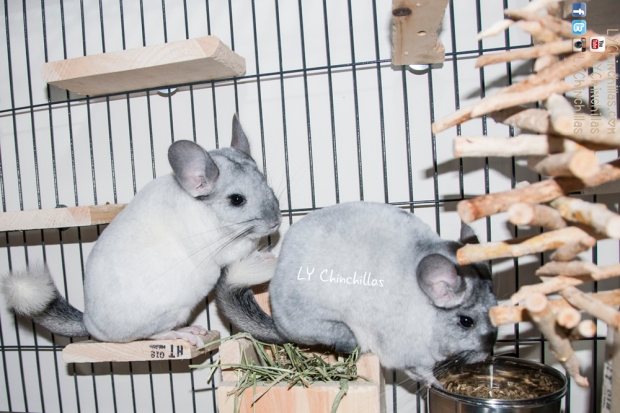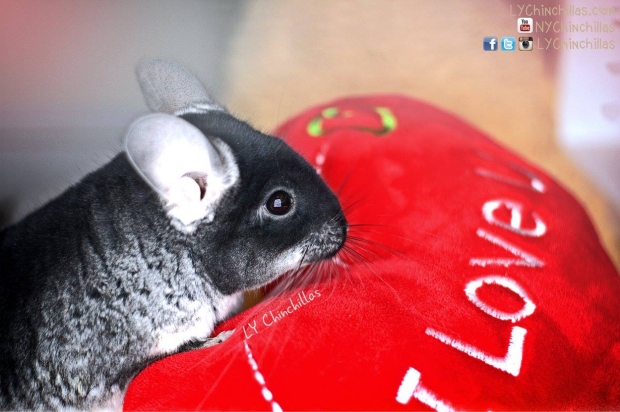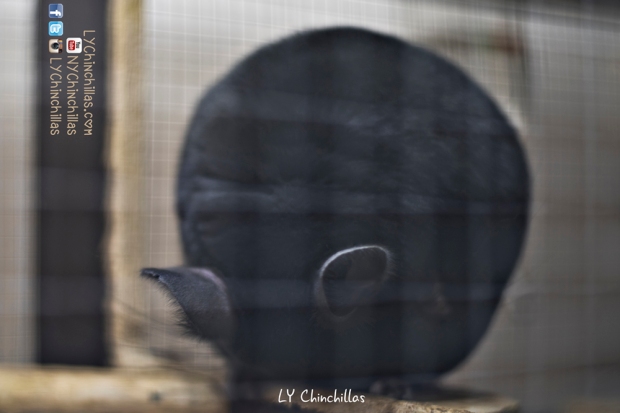One of our favorite ways to get festive during the holiday season is with winter-themed chinchilla photo shoots! This guide will go through my process with photographing LY Chinchillas on my own with no strobes or flash (basically, nothing fancy)! Be sure to have a fast camera (I use the Fujifilm X-T10 Camera because of the super-fast continuous shooting mode) and light sources ready to go! The very first thing to check prior to starting the shoot is the chin-proof factor. Admittedly, the actual time on set is very short – and the rest of the time is spent coaxing your little one back on set or sending them back to their cage to nap off a hard 10 seconds of work! In those off-set moments, you’ll need to make sure that everything is completely chin-proofed to prevent any accidents, fur loss, or injury.
The very first thing to check prior to starting the shoot is the chin-proof factor. Admittedly, the actual time on set is very short – and the rest of the time is spent coaxing your little one back on set or sending them back to their cage to nap off a hard 10 seconds of work! In those off-set moments, you’ll need to make sure that everything is completely chin-proofed to prevent any accidents, fur loss, or injury. The next thing you’ll want to check are your ambient light sources – that means your natural light, ceiling lights, desk lights, lamps, floor lamps, whatever other illuminating tools you may have in the shooting area. This will help capture your chinchilla by allowing you to have a faster shutter speed due to more available light. Normally, I prefer a clean white light, but for the holidays, there’s nothing wrong with a warmer glow that comes standard in most home lighting.
The next thing you’ll want to check are your ambient light sources – that means your natural light, ceiling lights, desk lights, lamps, floor lamps, whatever other illuminating tools you may have in the shooting area. This will help capture your chinchilla by allowing you to have a faster shutter speed due to more available light. Normally, I prefer a clean white light, but for the holidays, there’s nothing wrong with a warmer glow that comes standard in most home lighting.
Grab a portable spotlight if your natural lighting is low – ideally, this will be somehow diffused. You can do this by using a strong flashlight or adjustable desk lamp covered and tied down with a very sheer scarf. This will make sure that your light is not too harsh and capture your chinchillas in all their softness. The third step is to create your set: start out with a fun, safe idea and execute! Fleece is always great, but other textures can be visually pleasing too. For my holiday shoot this year, I went with simple silver and white tree decorations, along with a chunky knit sweater. It’s important to note that these decorations are obviously not safe for consumption, so I would not suggest this for anyone who is starting out with shoots; managing the talent on set is a huge part of the multitasking these types of productions require!
The third step is to create your set: start out with a fun, safe idea and execute! Fleece is always great, but other textures can be visually pleasing too. For my holiday shoot this year, I went with simple silver and white tree decorations, along with a chunky knit sweater. It’s important to note that these decorations are obviously not safe for consumption, so I would not suggest this for anyone who is starting out with shoots; managing the talent on set is a huge part of the multitasking these types of productions require! The final step is to shoot away! I like to set up the scene, get the lights on, take a few test shots, and then plop them in one by one to see how they react. Normally, my chins are very confused at the new environment, so they’ll take 10 seconds to look around before dashing off. Those 10 seconds are crucial! With a fast continuous shooting mode, you can grab up to 8 images per second – more than enough to finalize at least one adorable final shot.
The final step is to shoot away! I like to set up the scene, get the lights on, take a few test shots, and then plop them in one by one to see how they react. Normally, my chins are very confused at the new environment, so they’ll take 10 seconds to look around before dashing off. Those 10 seconds are crucial! With a fast continuous shooting mode, you can grab up to 8 images per second – more than enough to finalize at least one adorable final shot. Knowing your chinchillas, staying very patient, and setting realistic expectations is key: after shooting for years with them, I know that Fifi will be tough to contain (she has a strong dislike for unfamiliar environments) – so during this year’s shoot, she slipped out of the roster by her own sheer determination. Remember, it’s your own selfish cute-loving self who happens to be encouraging them to pose for adorable photos, so never get frustrated if things aren’t working out. If someone is being a diva, simply save the shoot for another day. Or, if you know a shoot is coming up, hold off on safe chews and treats for the week prior and let them munch on set. If difficulties arise, the rule is: better safe than sorry, always! It’s not worth straining your relationship with your beloved chin over some images.
Knowing your chinchillas, staying very patient, and setting realistic expectations is key: after shooting for years with them, I know that Fifi will be tough to contain (she has a strong dislike for unfamiliar environments) – so during this year’s shoot, she slipped out of the roster by her own sheer determination. Remember, it’s your own selfish cute-loving self who happens to be encouraging them to pose for adorable photos, so never get frustrated if things aren’t working out. If someone is being a diva, simply save the shoot for another day. Or, if you know a shoot is coming up, hold off on safe chews and treats for the week prior and let them munch on set. If difficulties arise, the rule is: better safe than sorry, always! It’s not worth straining your relationship with your beloved chin over some images. Don’t be apprehensive to reinvent the concept if needed. Sometimes, simple is better. A fleece backdrop and a chew stick can yield incredibly cute shots, too! Staying basic is an awesome way to start learning how your chins will behave in front of the lights and camera. It’s always truly just a buildup of trust, anyhow. We all wish you a very warm and happy holidays with tons of bonding and photography, sweet friends!
Don’t be apprehensive to reinvent the concept if needed. Sometimes, simple is better. A fleece backdrop and a chew stick can yield incredibly cute shots, too! Staying basic is an awesome way to start learning how your chins will behave in front of the lights and camera. It’s always truly just a buildup of trust, anyhow. We all wish you a very warm and happy holidays with tons of bonding and photography, sweet friends! 

LY Chinchillas Treat Donation
Donate healthy, delicious treats to LY Chinchillas to help keep our content going!
$5.00




 New DIY Goodies: I am a huge fan of DIY when it comes to the world of chinchillas:
New DIY Goodies: I am a huge fan of DIY when it comes to the world of chinchillas:  New Fleece: When the seasons change, so doth the fleece. While colors and designs bring a fresh new feel to their cages, it’s also important to discard fleece after a certain level of usage. Typically, when non-pill fleece starts to lose its original texture, that’s the sign to swap. Luckily, fleece ordered online is inexpensive and plentiful, meaning there’s tons of delightful – and affordable – designs to choose from!
New Fleece: When the seasons change, so doth the fleece. While colors and designs bring a fresh new feel to their cages, it’s also important to discard fleece after a certain level of usage. Typically, when non-pill fleece starts to lose its original texture, that’s the sign to swap. Luckily, fleece ordered online is inexpensive and plentiful, meaning there’s tons of delightful – and affordable – designs to choose from!


 New Accessories: Not only have we re-stocked on some fun hammocks for Muff and Koko, but we’ve also been fortunate enough to have discovered a new chinchilla vendor –
New Accessories: Not only have we re-stocked on some fun hammocks for Muff and Koko, but we’ve also been fortunate enough to have discovered a new chinchilla vendor –  While we’ve only managed to grab a few pumpkin and autumn-themed captures, we are keen on remaking
While we’ve only managed to grab a few pumpkin and autumn-themed captures, we are keen on remaking 





































